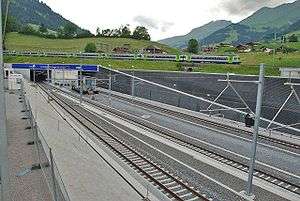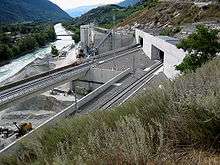Lötschberg Base Tunnel
 The Lötschberg Base Tunnel together with the century-old Simplon Rail Tunnel form the western part of the NRLA project (yellow: major tunnels, red: existing main tracks, numbers: year of completion) | ||||||||||||||||||||||||||||||||||||||||||||||||||||||||||||||||||||||||||||||||||||||||||||||||||||||||||||||||||||||||||||||||||||||||||||||||||||||||||||||||||||||||||||||||||||||||||||||||||||||||||||||||||||||||||||||||||||||||||||||||||||||||||||||||||||||||||||||||||||||||||||||||||||||||||||||||||||||||||||||||||||||||||||||||
| Overview | ||||||||||||||||||||||||||||||||||||||||||||||||||||||||||||||||||||||||||||||||||||||||||||||||||||||||||||||||||||||||||||||||||||||||||||||||||||||||||||||||||||||||||||||||||||||||||||||||||||||||||||||||||||||||||||||||||||||||||||||||||||||||||||||||||||||||||||||||||||||||||||||||||||||||||||||||||||||||||||||||||||||||||||||||
|---|---|---|---|---|---|---|---|---|---|---|---|---|---|---|---|---|---|---|---|---|---|---|---|---|---|---|---|---|---|---|---|---|---|---|---|---|---|---|---|---|---|---|---|---|---|---|---|---|---|---|---|---|---|---|---|---|---|---|---|---|---|---|---|---|---|---|---|---|---|---|---|---|---|---|---|---|---|---|---|---|---|---|---|---|---|---|---|---|---|---|---|---|---|---|---|---|---|---|---|---|---|---|---|---|---|---|---|---|---|---|---|---|---|---|---|---|---|---|---|---|---|---|---|---|---|---|---|---|---|---|---|---|---|---|---|---|---|---|---|---|---|---|---|---|---|---|---|---|---|---|---|---|---|---|---|---|---|---|---|---|---|---|---|---|---|---|---|---|---|---|---|---|---|---|---|---|---|---|---|---|---|---|---|---|---|---|---|---|---|---|---|---|---|---|---|---|---|---|---|---|---|---|---|---|---|---|---|---|---|---|---|---|---|---|---|---|---|---|---|---|---|---|---|---|---|---|---|---|---|---|---|---|---|---|---|---|---|---|---|---|---|---|---|---|---|---|---|---|---|---|---|---|---|---|---|---|---|---|---|---|---|---|---|---|---|---|---|---|---|---|---|---|---|---|---|---|---|---|---|---|---|---|---|---|---|---|---|---|---|---|---|---|---|---|---|---|---|---|---|---|---|---|---|---|---|---|---|---|---|---|---|---|---|---|---|---|---|---|---|---|---|---|---|---|---|---|---|---|---|---|---|---|---|---|---|---|
| Official name | German: Lötschberg Basis Tunnel | |||||||||||||||||||||||||||||||||||||||||||||||||||||||||||||||||||||||||||||||||||||||||||||||||||||||||||||||||||||||||||||||||||||||||||||||||||||||||||||||||||||||||||||||||||||||||||||||||||||||||||||||||||||||||||||||||||||||||||||||||||||||||||||||||||||||||||||||||||||||||||||||||||||||||||||||||||||||||||||||||||||||||||||||
| Line | Lötschberg Line | |||||||||||||||||||||||||||||||||||||||||||||||||||||||||||||||||||||||||||||||||||||||||||||||||||||||||||||||||||||||||||||||||||||||||||||||||||||||||||||||||||||||||||||||||||||||||||||||||||||||||||||||||||||||||||||||||||||||||||||||||||||||||||||||||||||||||||||||||||||||||||||||||||||||||||||||||||||||||||||||||||||||||||||||
| Location | Traversing the Bernese Alps in Switzerland | |||||||||||||||||||||||||||||||||||||||||||||||||||||||||||||||||||||||||||||||||||||||||||||||||||||||||||||||||||||||||||||||||||||||||||||||||||||||||||||||||||||||||||||||||||||||||||||||||||||||||||||||||||||||||||||||||||||||||||||||||||||||||||||||||||||||||||||||||||||||||||||||||||||||||||||||||||||||||||||||||||||||||||||||
| Coordinates | 46°34′41″N 7°38′56″E / 46.578°N 7.649°E – 46°18′32″N 7°49′55″E / 46.309°N 7.832°E | |||||||||||||||||||||||||||||||||||||||||||||||||||||||||||||||||||||||||||||||||||||||||||||||||||||||||||||||||||||||||||||||||||||||||||||||||||||||||||||||||||||||||||||||||||||||||||||||||||||||||||||||||||||||||||||||||||||||||||||||||||||||||||||||||||||||||||||||||||||||||||||||||||||||||||||||||||||||||||||||||||||||||||||||
| System | BLS, SBB CFF FFS | |||||||||||||||||||||||||||||||||||||||||||||||||||||||||||||||||||||||||||||||||||||||||||||||||||||||||||||||||||||||||||||||||||||||||||||||||||||||||||||||||||||||||||||||||||||||||||||||||||||||||||||||||||||||||||||||||||||||||||||||||||||||||||||||||||||||||||||||||||||||||||||||||||||||||||||||||||||||||||||||||||||||||||||||
| Start | Frutigen, canton of Bern, 780 m (2,560 ft) | |||||||||||||||||||||||||||||||||||||||||||||||||||||||||||||||||||||||||||||||||||||||||||||||||||||||||||||||||||||||||||||||||||||||||||||||||||||||||||||||||||||||||||||||||||||||||||||||||||||||||||||||||||||||||||||||||||||||||||||||||||||||||||||||||||||||||||||||||||||||||||||||||||||||||||||||||||||||||||||||||||||||||||||||
| End | Raron, canton of Valais, 654 m (2,146 ft) | |||||||||||||||||||||||||||||||||||||||||||||||||||||||||||||||||||||||||||||||||||||||||||||||||||||||||||||||||||||||||||||||||||||||||||||||||||||||||||||||||||||||||||||||||||||||||||||||||||||||||||||||||||||||||||||||||||||||||||||||||||||||||||||||||||||||||||||||||||||||||||||||||||||||||||||||||||||||||||||||||||||||||||||||
| Operation | ||||||||||||||||||||||||||||||||||||||||||||||||||||||||||||||||||||||||||||||||||||||||||||||||||||||||||||||||||||||||||||||||||||||||||||||||||||||||||||||||||||||||||||||||||||||||||||||||||||||||||||||||||||||||||||||||||||||||||||||||||||||||||||||||||||||||||||||||||||||||||||||||||||||||||||||||||||||||||||||||||||||||||||||||
| Work begun | 5 July 1999 | |||||||||||||||||||||||||||||||||||||||||||||||||||||||||||||||||||||||||||||||||||||||||||||||||||||||||||||||||||||||||||||||||||||||||||||||||||||||||||||||||||||||||||||||||||||||||||||||||||||||||||||||||||||||||||||||||||||||||||||||||||||||||||||||||||||||||||||||||||||||||||||||||||||||||||||||||||||||||||||||||||||||||||||||
| Opened | 14 June 2007 | |||||||||||||||||||||||||||||||||||||||||||||||||||||||||||||||||||||||||||||||||||||||||||||||||||||||||||||||||||||||||||||||||||||||||||||||||||||||||||||||||||||||||||||||||||||||||||||||||||||||||||||||||||||||||||||||||||||||||||||||||||||||||||||||||||||||||||||||||||||||||||||||||||||||||||||||||||||||||||||||||||||||||||||||
| Owner | BLS NETZ AG | |||||||||||||||||||||||||||||||||||||||||||||||||||||||||||||||||||||||||||||||||||||||||||||||||||||||||||||||||||||||||||||||||||||||||||||||||||||||||||||||||||||||||||||||||||||||||||||||||||||||||||||||||||||||||||||||||||||||||||||||||||||||||||||||||||||||||||||||||||||||||||||||||||||||||||||||||||||||||||||||||||||||||||||||
| Operator | BLS | |||||||||||||||||||||||||||||||||||||||||||||||||||||||||||||||||||||||||||||||||||||||||||||||||||||||||||||||||||||||||||||||||||||||||||||||||||||||||||||||||||||||||||||||||||||||||||||||||||||||||||||||||||||||||||||||||||||||||||||||||||||||||||||||||||||||||||||||||||||||||||||||||||||||||||||||||||||||||||||||||||||||||||||||
| Traffic | Railway | |||||||||||||||||||||||||||||||||||||||||||||||||||||||||||||||||||||||||||||||||||||||||||||||||||||||||||||||||||||||||||||||||||||||||||||||||||||||||||||||||||||||||||||||||||||||||||||||||||||||||||||||||||||||||||||||||||||||||||||||||||||||||||||||||||||||||||||||||||||||||||||||||||||||||||||||||||||||||||||||||||||||||||||||
| Character | Passenger, Freight | |||||||||||||||||||||||||||||||||||||||||||||||||||||||||||||||||||||||||||||||||||||||||||||||||||||||||||||||||||||||||||||||||||||||||||||||||||||||||||||||||||||||||||||||||||||||||||||||||||||||||||||||||||||||||||||||||||||||||||||||||||||||||||||||||||||||||||||||||||||||||||||||||||||||||||||||||||||||||||||||||||||||||||||||
| Technical | ||||||||||||||||||||||||||||||||||||||||||||||||||||||||||||||||||||||||||||||||||||||||||||||||||||||||||||||||||||||||||||||||||||||||||||||||||||||||||||||||||||||||||||||||||||||||||||||||||||||||||||||||||||||||||||||||||||||||||||||||||||||||||||||||||||||||||||||||||||||||||||||||||||||||||||||||||||||||||||||||||||||||||||||||
| Length | 34.5766 km (21.4849 mi) | |||||||||||||||||||||||||||||||||||||||||||||||||||||||||||||||||||||||||||||||||||||||||||||||||||||||||||||||||||||||||||||||||||||||||||||||||||||||||||||||||||||||||||||||||||||||||||||||||||||||||||||||||||||||||||||||||||||||||||||||||||||||||||||||||||||||||||||||||||||||||||||||||||||||||||||||||||||||||||||||||||||||||||||||
| No. of tracks | One single-track tube for 20km, two single-track tubes for 14km | |||||||||||||||||||||||||||||||||||||||||||||||||||||||||||||||||||||||||||||||||||||||||||||||||||||||||||||||||||||||||||||||||||||||||||||||||||||||||||||||||||||||||||||||||||||||||||||||||||||||||||||||||||||||||||||||||||||||||||||||||||||||||||||||||||||||||||||||||||||||||||||||||||||||||||||||||||||||||||||||||||||||||||||||
| Track gauge | 1,435 mm (4 ft 8 1⁄2 in) (standard gauge) | |||||||||||||||||||||||||||||||||||||||||||||||||||||||||||||||||||||||||||||||||||||||||||||||||||||||||||||||||||||||||||||||||||||||||||||||||||||||||||||||||||||||||||||||||||||||||||||||||||||||||||||||||||||||||||||||||||||||||||||||||||||||||||||||||||||||||||||||||||||||||||||||||||||||||||||||||||||||||||||||||||||||||||||||
| Electrified | 15 kV 16.7 Hz | |||||||||||||||||||||||||||||||||||||||||||||||||||||||||||||||||||||||||||||||||||||||||||||||||||||||||||||||||||||||||||||||||||||||||||||||||||||||||||||||||||||||||||||||||||||||||||||||||||||||||||||||||||||||||||||||||||||||||||||||||||||||||||||||||||||||||||||||||||||||||||||||||||||||||||||||||||||||||||||||||||||||||||||||
| Operating speed | up to 250 km/h (160 mph) | |||||||||||||||||||||||||||||||||||||||||||||||||||||||||||||||||||||||||||||||||||||||||||||||||||||||||||||||||||||||||||||||||||||||||||||||||||||||||||||||||||||||||||||||||||||||||||||||||||||||||||||||||||||||||||||||||||||||||||||||||||||||||||||||||||||||||||||||||||||||||||||||||||||||||||||||||||||||||||||||||||||||||||||||
| Highest elevation | 828 m (2,717 ft) | |||||||||||||||||||||||||||||||||||||||||||||||||||||||||||||||||||||||||||||||||||||||||||||||||||||||||||||||||||||||||||||||||||||||||||||||||||||||||||||||||||||||||||||||||||||||||||||||||||||||||||||||||||||||||||||||||||||||||||||||||||||||||||||||||||||||||||||||||||||||||||||||||||||||||||||||||||||||||||||||||||||||||||||||
| Lowest elevation | 654 m (2,146 ft) (south portal) | |||||||||||||||||||||||||||||||||||||||||||||||||||||||||||||||||||||||||||||||||||||||||||||||||||||||||||||||||||||||||||||||||||||||||||||||||||||||||||||||||||||||||||||||||||||||||||||||||||||||||||||||||||||||||||||||||||||||||||||||||||||||||||||||||||||||||||||||||||||||||||||||||||||||||||||||||||||||||||||||||||||||||||||||
| Grade | 3–13 ‰ | |||||||||||||||||||||||||||||||||||||||||||||||||||||||||||||||||||||||||||||||||||||||||||||||||||||||||||||||||||||||||||||||||||||||||||||||||||||||||||||||||||||||||||||||||||||||||||||||||||||||||||||||||||||||||||||||||||||||||||||||||||||||||||||||||||||||||||||||||||||||||||||||||||||||||||||||||||||||||||||||||||||||||||||||
| Route map | ||||||||||||||||||||||||||||||||||||||||||||||||||||||||||||||||||||||||||||||||||||||||||||||||||||||||||||||||||||||||||||||||||||||||||||||||||||||||||||||||||||||||||||||||||||||||||||||||||||||||||||||||||||||||||||||||||||||||||||||||||||||||||||||||||||||||||||||||||||||||||||||||||||||||||||||||||||||||||||||||||||||||||||||||
|
| ||||||||||||||||||||||||||||||||||||||||||||||||||||||||||||||||||||||||||||||||||||||||||||||||||||||||||||||||||||||||||||||||||||||||||||||||||||||||||||||||||||||||||||||||||||||||||||||||||||||||||||||||||||||||||||||||||||||||||||||||||||||||||||||||||||||||||||||||||||||||||||||||||||||||||||||||||||||||||||||||||||||||||||||||


The Lötschberg Base Tunnel (LBT) is a 34.57-kilometre (21.48 mi) railway base tunnel on the BLS AG's Lötschberg line cutting through the Bernese Alps of Switzerland some 400 m (1,312 ft) below the existing Lötschberg Tunnel. It runs between Frutigen, Berne, and Raron, Valais, and was built as one of the two centerpieces of the NRLA project. Breakthrough was in April 2005 and construction ended in 2006. The opening ceremony was in June 2007[1][2] Full scale operation began in December 2007,[3] and the link is currently saturated because a single-track section greatly reduces its capacity.
Project
Built to ease lorry traffic on Swiss roads, the LBT allows an increased number of lorries and trailers to be loaded onto trains in Germany, pass through Switzerland on rail and be unloaded in Italy. It also cuts down travel time for German tourists going to Swiss ski resorts and puts the Valais into commuting distance to Bern by reducing travel time by 50%. The total cost was SFr 4.3 billion (as of 2007, corrected to 1998 prices). This and the Gotthard Base Tunnel are the two centerpieces of the Swiss NRLA project.
Construction and usage
Track construction in the LBT was completed in July 2006. Extensive testing then took place, including more than 1,000 test runs, which focused among other things on the use of the ETCS Level 2 system. For the second half of 2007 (after opening), only regular freight used the LBT, plus some international and InterCity passenger trains (without stops between Spiez and Brig); however, passenger trains used the old timetable (the travel time between Spiez and Brig was considered to be 56 minutes until December 2007, even if actual travel time through the LBT was only about 30 minutes).
Since February 2008, the LBT has been used for normal InterCity routes. Travel time between Visp and Spiez is about 28 minutes (about 16 minutes in the LBT).
Completion status
Due to the soaring costs of the overall NRLA project, funds were diverted from the Lötschberg tunnel to the Gotthard Base Tunnel; and the LBT is only half finished. The fully complete LBT will consist of two single track bores side by side from portal to portal, connected about every 300 m (984 ft) with cross cuts, enabling the other tunnel to be used for escape.[4]
Currently from South to North a third of the tunnel is double track, a third is single track with the second bore in place but not equipped, and a third is only a single track tunnel with the parallel exploration adit providing the emergency egress. The construction was divided into 3 phases with only phase 1 completed to date:
- Phase 1: construction of about 75% of the length of the West tube and the complete East tube of the main tunnel, the Engstlige tunnel, the two bridges across the Rhône, and the branch bore from Steg. Tracks are laid in the Eastern tubes of the LBT and Engstlige tunnels, and for some 12 km (7.5 mi) in the western tube of LBT, starting from the South.
- Phase 2: laying of tracks in the bored but not equipped part of the western tube of LBT, and in the western tube of Engstlige tunnel.
- Phase 3: construction of the remaining 8 km (5.0 mi) of the western tube, laying tracks on the Steg branch, and connection of this branch to the main line Brig-Lausanne, but towards Lausanne.
Phases 2 and 3 may be done together. Completing the LBT is estimated to cost 1 billion Swiss francs. The project also includes two parallel bridges over the river Rhône in canton Valais, the 2.6 km (1.6 mi) Engstlige tunnel (built with cut-and-cover method; the 2 tracks are separated by a wall). A planning contract for phases 2 and 3 was awarded in 2016.[5]
Operation
About 110 trains per day use the LBT, and 66 have to use the old mountain tunnel because the single track section severely limits the capacity of the base tunnel. Of the 110, 30 are passenger and 80 are freight, including both intermodal freight transport and long-distance heavy freight trains. Heavy freight trains up to a maximum weight of 4,000 tons and a maximum length of 1,500 metres have to use the LBT, as they cannot use the existing mountain track.
The 21 km of single track without passing loops greatly complicate operations, and trains are scheduled by batches in each direction separated by long intervals; trains more than 7 minutes late are either routed via the old line or must wait for the next available timetable slot in their direction in the LBT, incurring further delay in either case.
Travel speeds
- Regular freight trains: 100 km/h (62.1 mph)
- Qualified freight trains: 160 km/h (99.4 mph)
- Passenger trains: 200 km/h (124.3 mph)
- Tilting passenger trains: 250 km/h (155.3 mph)
Geothermal energy
The warmth of the water flowing out of the tunnel is used to heat the Tropenhaus Frutigen, a tropical greenhouse producing exotic fruit, sturgeon meat and caviar.
See also
Notes and references
- ↑ Klapper, Bradley S. (2007-06-15). "Swiss Open World's Longest Land Tunnel". Washington Post. Retrieved 11 May 2010.
- ↑ "Huge Swiss tunnel opens in Alps". BBC. 2007-06-15. Retrieved 2007-06-19.
- ↑ TSR Journal 15/06/2007, édition du 19h30
- ↑ TSR "Gotthard: From Dream to Nightmare" "Temps Present" 24 May 2007
- ↑ http://www.railjournal.com/index.php/europe/planning-contract-awarded-for-lotschberg-base-tunnel-track-doubling.html
External links
| Wikinews has related news: Swiss finish drilling world's longest overland tunnel |
- Official project site
- Official site of the "ARGE Bahntechnik Lötschberg" the general contractor for the railway technology
- Alptransit Portal of the Swiss Federal Archives
- Site with a movie documentation about the engineering and the works(railway technology)
- MSNBC report on the tunnel breakthrough, 28 April 2005
- Rail Technology in the Lötschberg Base Tunnel
- Image Gallery on a contractors site